| Columns Retired Columns & Blogs |
May be JCA could review the new Rotel Michi M8 mono-block amps, 1080 WPC into 8 Ohms and 1800 WPC into 4 Ohms, $14,000/pair :-) ........
As with the Audio Research Reference 160 M amplifier that was reviewed in the October 2018 issue of Stereophile, measuring the Reference 160 S was a complicated business. The amplifier has balanced and single-ended inputs, output stages that can be run in either triode or Ultralinear mode, and three output-transformer taps. In effect, it is 12 different amplifiers. I performed full sets of tests using the balanced inputs in both triode and Ultralinear modes from the 4 ohm, 8 ohm, and 16 ohm output taps, then repeated some of the tests using the single-ended inputs. After I installed the tubes, I used the Tube Check button on the front panel to make sure all was well with the eight KT150 beam tetrode output tubes; the four LEDs for each channel illuminated green, indicating no problems.
I tested the REF 160 S with my Audio Precision SYS2722 system (see the January 2008 "As We See It"). As with the REF 160 M, the amplifier's voltage gain at 1kHz into 8 ohms depended on the input, mode, and output tap. Using the balanced inputs and Ultralinear mode, I measured 26.4dB from the 16 ohm tap, 24.2dB from the 8 ohm tap, and 21.5dB from the 4 ohm tap. In triode mode, these gains were all 0.5dB lower and, as with the monoblock amplifier, the unbalanced inputs offered 6dB more gain than the balanced inputs. The amplifier's balanced inputs preserved absolute polarity (ie, were noninverting) with both output modes and from all output taps. However, the unbalanced inputs inverted polarity. The balanced input impedance was usefully high at >220k ohms at 20Hz and 1kHz, dropping to 192k ohms at 20kHz. The unbalanced input impedance was 49k ohms at low and middle frequencies, dropping to a still-high 26k ohms at the top of the audioband.
The REF 160 S's output impedance depended on mode and output tap. In triode mode from the 8 ohm tap, the impedance ranged from 0.7 ohm at 20Hz to 0.8 ohm at 1kHz and 1.1 ohms at 20kHz. The impedance was higher from the 16 ohm tap, ranging from 1.1 to 2 ohms, and lower from the 4 ohm tap, ranging from 0.42 to 1.1 ohms. The output impedances were all slightly higher in Ultralinear mode, but even so, for a tube amplifier, the REF 160 S has a commendably low output impedance in all of its modes. Consequently, the modulation of the amplifier's frequency response, due to the Ohm's law interaction between this source impedance and the impedance of our standard simulated loudspeaker, was relatively small, at ±0.7dB (figs.1 & 2, gray traces).
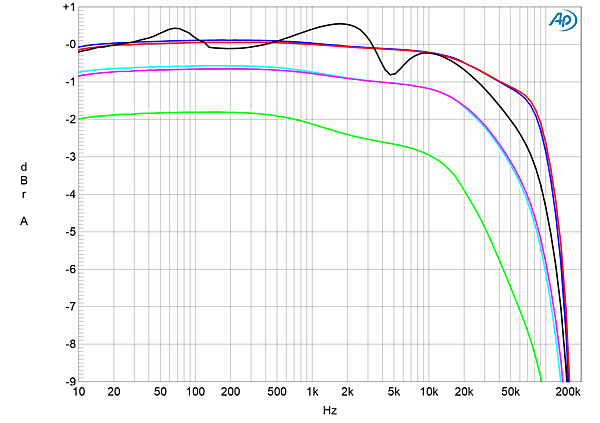
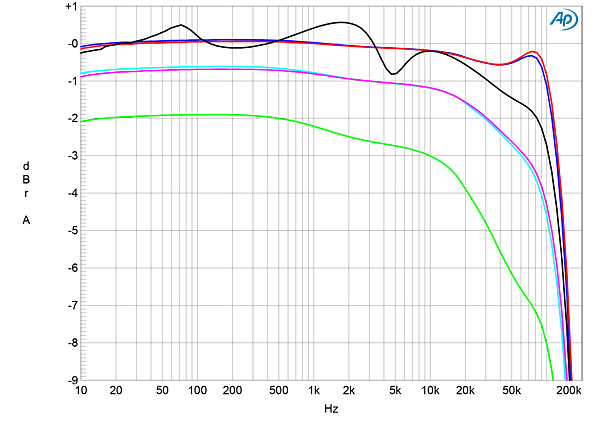
Fig.1 was taken in triode mode from the 8 ohm tap; the behavior from this tap in Ultralinear mode (fig.2) was almost identical, though a small ultrasonic peak can be seen into 8 ohms (blue and red traces). In both modes, the response into 8 ohms (figs.1 & 2, blue and red traces) was flat in the midrange, with a slight tilt-down in the treble that became more pronounced as the load impedance fell. In the worst case, with the 8 ohm tap driving 2 ohms (figs.1 & 2, green traces) or the 16 ohm tap driving 4 ohms (not shown), the output was down by 2dB at 20kHz. This is associated with slightly lengthened risetimes with the amplifier's reproduction of a 10kHz squarewave under these conditions (fig.3). A small overshoot can be seen when the load impedance is higher than the nominal tap impedance (fig.4). This correlates with the small ultrasonic peak in the frequency response in fig.2, but the squarewave is free from ringing.
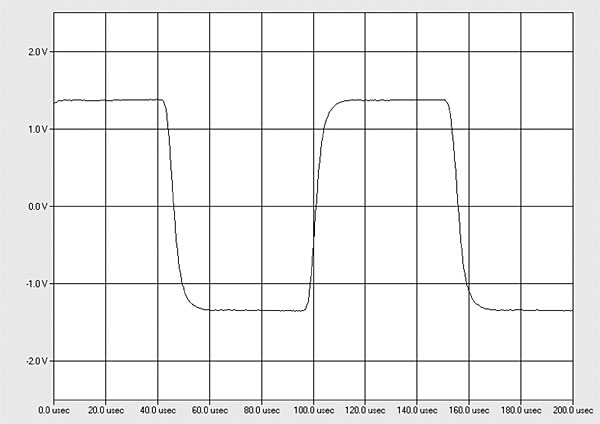

Channel separation was excellent, at >90dB in both directions below 2kHz, falling to an okay 66dB at the top of the audioband. Measured at the 8 ohm taps and taken with the unbalanced inputs shorted to ground, the amplifier's unweighted, wideband signal/noise ratio was 82dB, ref. 1W into 8 ohms, this ratio improving to 89.2dB when the measurement was A-weighted. The S/N ratios were about 2.5dB higher from the 4 ohm taps and 2dB lower from the 16 ohm taps, this behavior correlating with the respectively lower and greater gains from these taps. Spuriae at the 60Hz power-supply frequency and its harmonics were present in the REF 160 S's noise floor at low levels but were a little higher in the left channel (fig.5, blue trace) than the right (red).
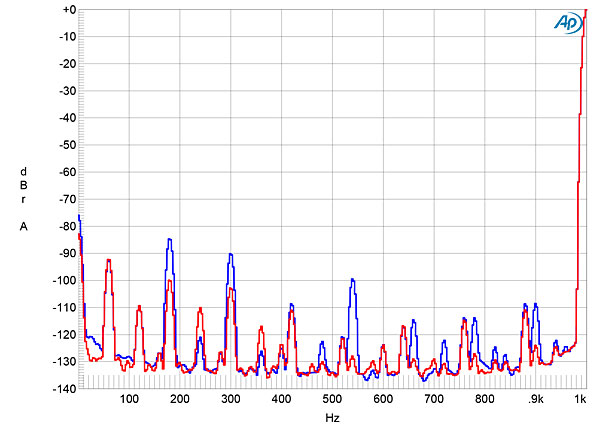
The REF 160 S is specified as delivering up to 70W into 8 ohms (18.45dBW) in triode mode and 140W into 8 ohms (21.5dBW) in Ultralinear mode. Using our definition of clipping, which is when the output's percentage of THD+noise reaches 1%, the amplifier with both channels driven in triode mode with a 1kHz signal clipped at 70W when the load was matched to the output transformer tap (fig.6). The clipping power in Ultralinear mode was at least 140W, again when the load and output tap were matched (fig.7). Less power was available when the load was not matched to the nominal transformer tap. In triode mode from the 8 ohm tap, the REF 160 S clipped at 70W into 8 ohms (fig.8) but at 61W into 4 ohms (14.8dBW, fig.9). With the worst mismatching, the REF 160 S clipped at 31W (11.9dBW) from the 16 ohm tap driving 4 ohms and 26W (8.1dBW) from the 4 ohm tap driving 2 ohms, in both triode and Ultralinear modes.
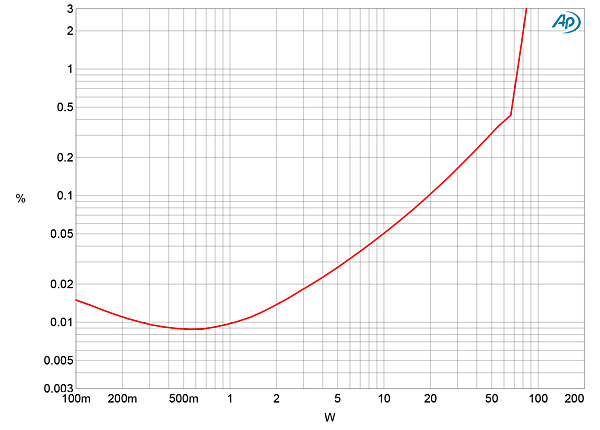
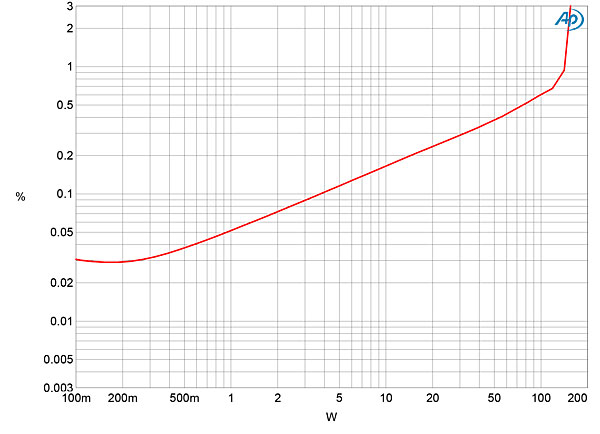
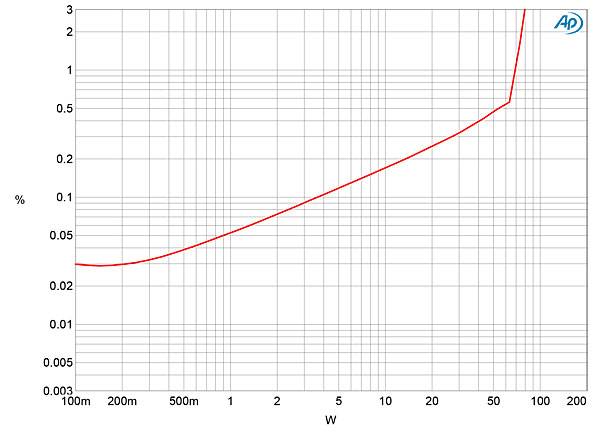
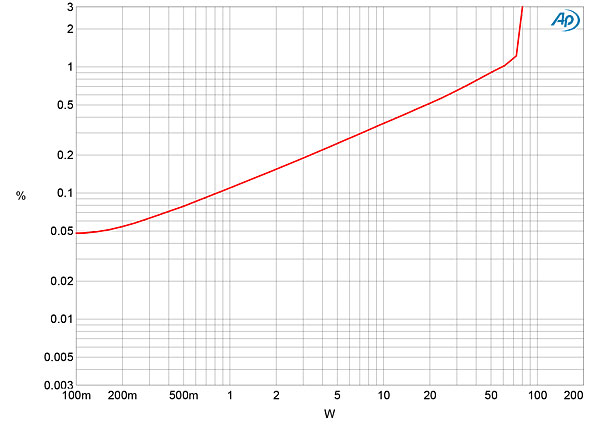
As with the REF 160 M, the upward slope of the traces in figs. 6–9 suggests that the REF 160 S uses only a modest amount of loop negative feedback. I examined how the percentage of THD+noise changed with frequency at 6.33V, which is equivalent to 2.5W into 16 ohms, 5W into 8 ohms, 10W into 4 ohms, and 20W into 2 ohms. The THD+N was very low in the midrange into 16 ohms from the 16 ohm tap in Ultralinear mode (fig.10, gray trace), but rose both at higher frequencies and into lower impedances. The THD+N was very high in level across the audioband from the 16 ohm tap into 4 ohms (cyan and magenta traces); the amplifier is being driven into clipping above 8kHz at 10W into 4 ohms. The distortion from the 8 ohm tap into 8 ohms in Ultralinear mode was slightly higher than it was from the 16 ohm tap, as it was in triode mode. However, while the 4 ohm tap offered low distortion in both modes when the load impedance was greater than 4 ohms (fig.11, green, blue, and red traces), the THD+N was high into 4 ohms (cyan and magenta traces). Into 2 ohms, from the 4 ohm tap, at 20W output, THD is above our 1% definition of clipping at 1kHz and above (gray trace).
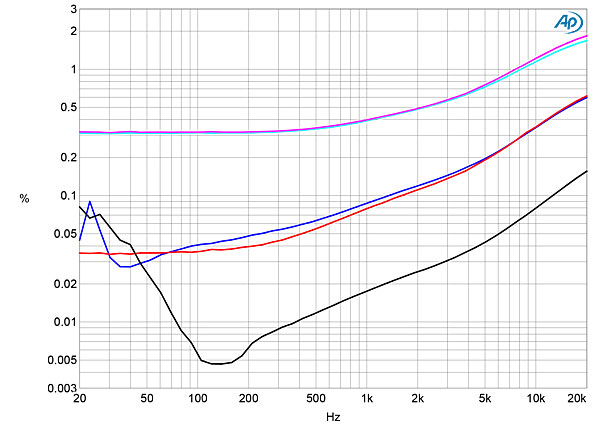
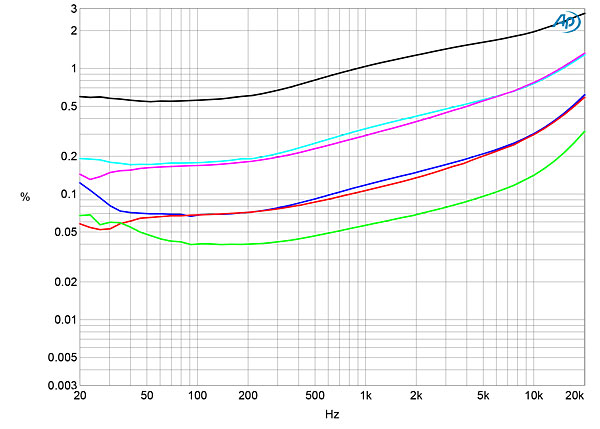
Fortunately, the REF 160 S's distortion was predominantly the subjectively innocuous second harmonic (fig.12), and higher harmonics other than the third are all low in level (fig.13). This spectrum was taken into 8 ohms from the 8 ohm tap. Dropping the load to 4 ohms (fig.14) increased the levels of both the second and third harmonics, with the third now equal in level to the second. When the amplifier drove an equal mix of 19 and 20kHz tones at 10W into 8 ohms from the 8 ohm tap in Triode mode (fig.15), the second-order difference product at 1kHz lay just below –60dB (0.1%) and the higher-order intermodulation products were lower in level. As with the Audio Research Reference 160 M monoblock, the REF 160 S's measured performance is affected by the design team's decision not to use a lot of loop negative feedback. The amplifier will offer relatively high levels of low-order harmonic distortion when the load impedance is less than the nominal output transformer tap, so owners should make sure that the impedance of their loudspeakers is not significantly lower than the value of the output tap that gives sufficient loudness.—John Atkinson
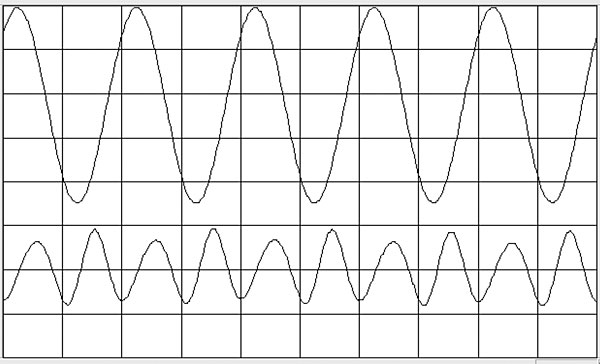

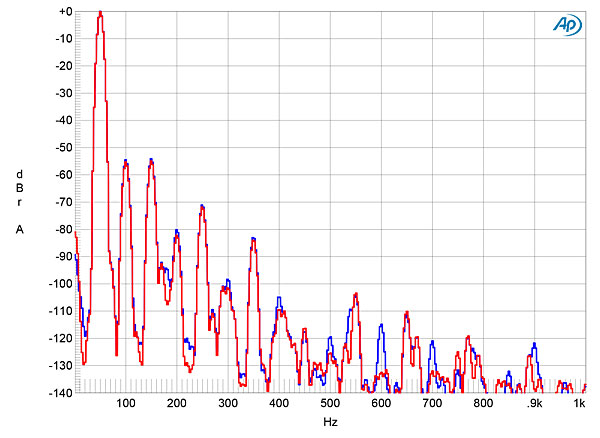
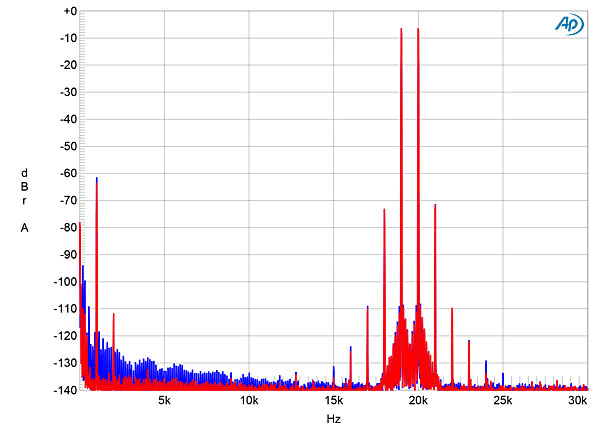

May be JCA could review the new Rotel Michi M8 mono-block amps, 1080 WPC into 8 Ohms and 1800 WPC into 4 Ohms, $14,000/pair :-) ........

Also, JCA could review the new McIntosh MC901, tube/transistor amplifier, $17,500 :-) .......

The best sound at any show I ever heard came from an AR integrated along with an AR CD9? CD player, paired with Verity Audio speakers. CD after CD played revealed detail and lifelike presentation that no system at any show I've attended has ever matched. I can only imagine how good this combo sounds. I wish I could borrow for a month and call in sick from work for 22 straight days.

... irresistible could well be the characteristics of the polypropylene plastic cones used in the mid-range and woofer drivers of the Verity Audio speakers combined with a dose of second harmonic "sauce" generated by the ARC electronics.
For comparison, try Spendor or Harbeth speakers driven by a tube amp.

Not sure how to respond, but at the same show in another room were the more prominent Verity Audio speakers with Nagra tube amplification and DCS digital front end and it did not sound as intimate as the smaller Verity's with the ARC electronics. As for Harbeth, they are one of my faves and have heard them with the top end Rega electronics, they sound beautiful and I want them but none of them captured that sound in that room that day. I suppose this was one perfectly matched system, but I do not doubt that the ARC integrated tube amp and CD9 contributed significantly to that fantastic sound. I have not heard ARC in any other configuration, but if they all sound like that, then I am sold.

William Z is smiling :-) ......

Not surprising... dCS is the antithesis of musicallity ;-). Nagra, on the other hand, is a synonym of this elusive term.

This was back in 2008 or 2009, don't exactly remember, it was a while ago, maybe the dcs gear back then had a different sound, I am no expert in that gear. But it didn't have the "I could almost reach out and touch the musicians" feel the way the cheaper ARC/Verity combo did.

Have to admit that my experience of dCS was also some time ago but now I have been playing with a Nagra CDP, I know what I missed in the "old days". But it is all subjective, if dCS touches your heart, go for it. If it doesn't, steer away from it.

You can get '22 Days Nutrition' organic nutrition bars and powder, for 22 straight days :-) .........

So maybe they might help. First, someone has to lend me the amps.

Jim - thanks for the great review. Do you have any comparison to other amps? Not that I don't trust what you heard, which you have very good skills at describing. But, in this subjective hobby of ours, it provides tremendous value when you compare it against other options the readers may have or other well-known amps. You have Pass Labs XA60.8, which is another amp known to produce a beautiful sound. How did ARC compare against it in its sonic bliss? You also have PS Audio BHK 300, which has a great dynamic. How did ARC compare against it on dynamic or driver grip? I would very much appreciate it if you can add some comparison. Because without a meaningful comparison, a review can be just too subjective or personal.

... with distortion levels approaching those of the Benchmark AHB2?
If so, would it be likely to exhibit the same sort of "musicality" and/or "tonal beauty" that JA2 has observed from the Reference 160S?
Regarding the "impressive price" of $30K for a pair of ARC Reference 600 monoblocks in the mid-1990s, back then there were other manufacturers offering monoblock amps at that price point - and well above.
Among them were the Accuphase M-100 ($30K), Audire Monarch ($60K), Denon POA-S1 ($40K), Jadis JA-500 ($35K) Krell Audio Standard ($35K) and, last but not least, the Audio Note Gaka-On ($250K).

You are missing the whole point ........ The fundamental idea of a tube amp is not to measure and sound like a transistor amp :-) ........

... measure and what should it sound like?

Even the best and experienced audio reviewers (and measurers) don't know the answer :-) .......

... Hafler type straight wire differential tests - with the amp under evaluation connected to Stereophile's standard simulated loudspeaker load.
The amp which achieves the best measured null on that test will then be the "best" amp.
https://www.stereophile.com/solidpoweramps/hafler_xl-280_power_amplifier/index.html
If two, or more, amps should happen to exhibit similar performance on the null test, then move on to blind, level-matched comparisons.
Otherwise, the reviewers can keep on performing uncontrolled listening tests on different amps, in different systems and with different music all the while trying to select the one that sounds to them to be the most pleasant - in spite of audible levels of distortion and frequency response that varies with load.

Hi
"..... amplifiers to allow switching between triode and Ultralinear operation." quoted Jim Austin.
VTL got its tetrode power amps with switchable triode & tetrode operation decades back. How come ARC took so long to do so until now?
Likewise, I consider I have done the best ever sonic upgrade of my vintage Dynaco ST-70 35W+35W power amp by converting it to triode/pentode ultra-linear switchable over a decade ago.
That said, we should know the sonic downside of trioded pentode/tetrode by strapping the screen grid to its plate with a low-resistance resistor, a conventional way used by brandnamed amp manufacturers & DIYers alike since day one decades back. So the grid screen is working at a voltage almost the same as the plate.
I have read many reports criticizing such simple trioding method causing the sound somewhat soft, weak & punchless vs its original pentode/tetrode configuration. Unacceptable to my critical ears, to say the least.
To fix such sonic 'problem', I set the operating voltage of the screen grid, STABILIZED, LOWER than the plate as it were working as a pentode/tetrode. Ite is done by connecting the screen grid to the plate with a circuit of diodes, fast quality capacitors, & resistors.
I would label it as: "plate/screen grid split potential topology".
The key issue is: what is the proper voltage difference between the plate & the screen grid to get the best sound.
After enough trial & error, I finally get the right potential difference between the screen & the plate. It works like a chime: it sounds
fast, punchy & forceful like a pentode/tetrode & beats the latter by being more defined, smoother, & transparent like a real triode.
I have used it first in trioding my Dynaco ST-70 power amp & my ALL other later power amp projects. The trioded Dynaco sounds so good that I have left it switched to triode mode for ever.
Added merit: Such split potential triode conversion does not sound noticeably lower than its pentode mode though its output power is rated only half of its pentode operation !
Listening is believing
Jack L
Canada

"To fix such sonic 'problem', I set the operating voltage of the screen grid, STABILIZED, LOWER than the plate as it were working as a pentode/tetrode. Ite is done by connecting the screen grid to the plate with a circuit of diodes, fast quality capacitors, & resistors"
Or instead of modifying a Dynaco/Dynakit, build an amplifier using a better output transformer with a separate center tapped winding for the screen grids, better providing for lower subregulated nominal voltage well below the B+ rail voltage powering the anodes. And you can get that output transformer with cathode tapes, separate windings for the cathodes.
The old Audio Research VT 150 SE had all of that. Not sure about the amplifier under review here.
Your old Dynaco/Dynakit amplifier was built to sell at a much lower price point and did not have those features, rather saved on build cost with only two windings, primary and secondary, with multiple taps.
If you want to DIY, consider using Menno van der Veen's VDV-2100-CFB-SSCR-PPS.
https://mennovanderveen.nl/cms/images/producten/VDV-2100-CFB-SSCR-PPS/2018-11-09_VDV-2100-SSCR-CFB-PPS_datasheet-1.pdf
https://mennovanderveen.nl/cms/images/producten/VDV-2100-CFB-SSCR-PPS/2018-11-09_VDV-2100-SSCR-CFB-PPS_datasheet-2.pdf
https://mennovanderveen.nl/cms/index.php/nl/producten/specialist/vdv-2100-cfb-sscr-pps-detail

....... a better output transformer.." quoted JRT.
You are comparing apple to orange, my friend!
I said "UPgrade" but you meant to say "Rebuild". We are in different wavelengths.
Tons of so called "upgrades" (which were actually "rebuilds) of Dynaco
since day one half a decade back. It involved rebuilding the entire driver board with different tubes, replacing the original output & even power transformers, etc etc. So such drastic rebuild made Dynaco sounded
like something else. Gone was the original famous award-winning Dynaco sound.
What I have done to my Dynaco was to maintain its original sonic signature by keeping the major crucial components, e.g. driver board, output & power transformers.
The most substantial sonic improvement was to convert the Dynaco ST-70 to triode & pentode switchable using my unique design/built "plate/screen grid split potential topology". Triode sound is always much better than pentode sound even using the very expensive brandnamed ultra-linear output transformers. I achieved the sonic improvement yet saved a bundle.
Any other upgrades I also did would be icing on Dynaco's cake, e.g. replacing all passive parts, e.g. now using polypropylene metal-film coupling capacitors, film resistors, fast recovery silicon rectifiers, HV motor-run OIL filter caps (replacing the vintage HV multi electrolytic cap) etc.
Much improved sound the Dynaco style without need to spend a bundle to replace major items.
Listening is believing
Jack L

...those see thru Meterings.
I've owned large ARC Amps, they look & give off the "I'm a certified audiophile" feeling with publicly claiming "ARC ownership" a Statement of audiophile authenticity but it might be more bluster than ultimate performance. I've heard a few ARC Electronic Based Systems that didn't perform as hoped or expected.
It might be simpler to build around KRELL or PS Audio or PASS gear because they lack tubes. ( and solid state devices last forever-- as claimed by Nelson Pass )
Tube life of 3,000 hours seems rather hopeful. 3,000 hours could equate to a Decade or likely less than 2 years of 5 hour listening days. So, a spare set of Tubes needs standing-by. My experience would predict less than 1,000 hours.
Tube Amp buyers are Brave, I have to hand it to them, especially if they are running those pricy KT150s.
Tony in Venice
ps. those Glass Meters are gorgeous Impulse buyer magnets & so are the Diavialet Amps with their remote control and wall mounting.

.......Tube life of 3,000 hours seems rather hopeful. 3,000 hours could equate to a Decade or likely less than 2 years of 5 hour listening days"
"Tube Amp buyers are Brave, I have to hand it to them, especially if they are running those pricy KT150s." quoted tonykaz.
First off, how long you owned yr tube gears before you switched to sold states ?
You worry about vacuum tube lifespan?
Let me tell you, the 60-year-young vintage Telefungen ECC83 tubes still work perfectly in my design/built phono-preamp, excellent sounding. It renders me timeless pleasure on my 1,000+ vinyl collection !
Yes, transistor amps may last "for ever" if you are lucky. But so what?
My critical ears can't tolerate the clinical sonic of any solid state amps, sorry !
Listening is believing
Jack L
Canada

I've owned and maintained Tube Gear since the 1950s . I've owned Macintosh Tube gear that went thru tubes on a 6 month basis.
Tubes are our finest sounding Audio Amplifiers, which is why we still bother with them. They all tend to have differing sound qualities and can have magnificent singing "voices" ( my opinion ).
I do worry about Tube Life because they are so dam hard to find and tend to have such short "peak" lives, whilst great SS gear never seems to cease. ( I have seen recent unserviceable NAD SS gear fail and get tossed into Waste Management's infinite mountain)
People that achieve outstanding Sound Quality with factory serviceable Solid State Designs deserve the accolades they get.
Tony in Venice
ps. You have good fortune in the ECC83s you own ( maybe it's because you live in a humane Canada ) , great sounding ones will cost mucho dinero today. ( but they are out there as are great sounding SS gear )
ps.2) I know folks that have owned Tube gear only, no SS. They miss out on headroom but live a pleasant midrange life. ( my opinion )

..... out on headroom but live a pleasant midrange life. ( my opinion )"
quoted tonykaz.
Only your opinion is OK.
Yet I would like to change yr opinion on good tube amps.
This is what happened just a couple of weeks ago with my curious audio fans came by my home basement audio den, to audition first time how my home-brew 9W+9W SET (single-ended tube) power amp using 2x2A3 direct-heated triode power tubes would perform.
Making miraculous illusion like David Copperfield using a small 9W+9W tube power amp ?
It is real ! All I did some years back was to install 3x100W active subwoofers to L, R & L+R channels of my stereo system, all hooked up to my design/built stereo phono-preamp !
Here how my little "David" killed "Goliath".
I tried out the Tchaikovsky 1812 Overture on CD, with my 9W+9W amp + 3 subwoofers on. We could virtually feel the thouderous battlefield effect, with cannon cells virtually flying upfront right over & well beyond our heads. My audio fans dropped their jaws bigtime.
My wife came down to find out what was happening, saying:"The floor above was shaking!!!!"
Can a thousand watted solid state power amp produce such convincing climax effect ???
Listening is believing
Jack L

I didn't realize that you are that differing type of old school DIY system builder able to extrapolate out and achieve your greatness.
There are only a small few of you advanced souls. You inhabit a unique world.
I am living in the world of "Pocket" systems but I know the delights of your pursuits. You'd be a gourmand if you we're a food guy. We should have a special name for y'all like we do for Ham Radio people that prefer ultra low power ( QRP )
Well, Mr. Jack, nice reading and writing to you here at the Stereophile's Campfire, I hope Mr.Dudley does a Story about you.
Tony in Venice

..... old school DIY system builder able to extrapolate out and achieve your greatness..." quoted tonykaz.
Thanks yr complement.
MY way: "Think OUTSIDE of the box !"
Jack L

... tossed really unserviceable, or was the repair cost simply deemed too high relative to the price of a new replacement unit?
Also, a repair shop used to working on point-to-point wired tube equipment or solid-state products with through-hole circuit boards might take one glance at a unit populated with surface-mount devices and declare that it's unserviceable. However, just because they might not be equipped to fix it doesn't mean that no one can.

I have/had a Servicemen : Morel TV in Farmington Michigan that is a critic of "modern" manufacturers selling gear that cannot be serviced. He is not alone, there are Youtube videos by Service Techs that clearly illustrate and Show how our electronics are sealed by the factory.
I'm asking Stereophile Editors to establish Serviceability as part of their review process.
Morel has a back room with stacks of Consumer Audio Gear that is unserviceable with owners not returning to collect their broken pieces.
Of course, some gear could be too costly to service but that is not what I'm referring to.
Some outfits ( Apple, I'm told ) attempts to block anyone from servicing their gear ( including legal blocks in Court Rooms ).
My point, my rant is that we should be allowed to know about service before we invest.
Sales outlets offer extended warrantees, for a stiff price but those warrantees get the owner a NEW box, not a repair. ( I think )
Are ALL NAD products serviceable? I don't think so.
Be careful about this.
This entire issue revolves around Chinese sourced products.
Tony in Venice

... that you and/or the TV repair shop consider to be unserviceable?
NAD has been sourcing most, if not all, of its electronic product line from China for quite some time.
Looking at a few of the sites that have service manuals available for download, manuals are shown for many of those made-in-China NAD products.
One example is for the C368 integrated amp from the current product lineup:
https://elektrotanya.com/nad_c_368.pdf/download.html

I'm not a NAD watchdog or watching any other brands ( for that matter ).
My concerns revolve around the trend of Manufacturers to block their products from the 3 Billion Dollar aftermarket Service industry and from their customers knowing about the unservability of their wonderful creations.
I am encouraging Stereophile's Management to include Service as part of the review process.
Some outfits : Schiit, PS Audio, Audio Research ( ARC ) are recognized for featuring Serviceability as part of their ownership experience. ( Apple doesn't seem to even allow their Schematics to be known )
On the plus side, our reviewers have mentioned that a reviewed device had defects needing attention ( sometimes considerable attention ).
Tony in Venice

The notion that the value and enjoyment of music has anything to do with the expense or sound quality of your playback system is the same as the notion that the value and enjoyment of a movie like "The Godfather" has anything to do with the expense or the resolution of the TV picture that you're watching it on.

JCA could also review the conrad-johnson ART 150 stereo amp ($19,500) ........ About the same power output and about the same price of ARC 160S :-) ..........

From the review:
For a company to design its own internal parts was unusual—and remains so—as was the notion that specific capacitor and wiring choices sound quality. And yet, even though transistors were not could affect the sound of an amplifier.
Two consecutive sentences. Does anyone actually read these?

>>Two consecutive sentences. Does anyone actually read these?
Apparently they do--otherwise, how could you have noticed the errors? We call it beta testing. :-)
Seriously, it was perfect in print. Sometimes errors are introduced when copy is prepared for online publication. I'll fix it now.
Jim Austin, Editor
Stereophile